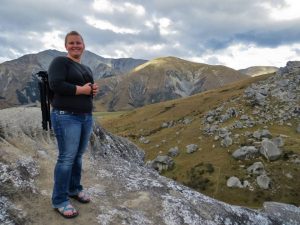19 September 2017
Researchers take on atmospheric effects of Arctic snowmelt
Posted by Lauren Lipuma

Peter Peterson, one of the student authors studying atmospheric chemistry in the Arctic.
Credit: William R. Simpson.
By Sue Mitchell
Researchers at the University of Alaska Fairbanks’ Geophysical Institute are exploring the changing chemistry of the Arctic’s atmosphere to help answer the question of what happens as snow and ice begin to melt.
The research is concerned with the Arctic’s reactive bromine season, the period of time when bromine is consuming ozone, producing bromine monoxide and oxidizing mercury.
“There’s a really profound difference between solid water and liquid water in terms of reactivity,” said William Simpson, an atmospheric chemist at the University of Alaska Fairbanks and lead author of a new study detailing the research in the Journal of Geophysical Research: Atmospheres, a journal of the American Geophysical Union. “Because the reactive bromine season ends when snowpack begins to melt, “earlier melt is changing what is happening in the atmosphere.”
While scientists studying the Arctic typically have a narrow time window to gather information, Simpson’s research group used a year-round data set that included buoy-based observations in the Arctic Ocean.

Justine Burd, one of the student authors studying atmospheric chemistry in the Arctic.
Credit: William R. Simpson.
Peter Peterson, one of Simpson’s student researchers, noted a predictive application of the research: an increased understanding of bromine reactivity could help scientists figure out how “the atmospheric composition in the Arctic might respond to rapidly changing sea ice conditions.”
“Monitoring the seasonal end date each year could give us an indication of climate change as well, since it correlates to temperature change,” said Justine Burd, the student researcher who processed the data and research correlations. “Is the bromine season ending earlier each year, staying approximately the same, or getting longer?”
In Utqiaġvik, the melt season has lengthened approximately eight days per decade, while in the pan-Arctic region the season has lengthened approximately five days per decade. As the snowmelt season lengthens, the bromine season becomes increasingly shorter.
“Knowing how snow and ice affect the atmosphere is becoming even more important considering the changing Arctic ice pack and changing Arctic temperatures,” Simpson said. “This narrow work is one part of a big, broad question: what happens when snow starts to melt?”
— Sue Mitchell is a public relations manager at the University of Alaska Fairbanks. This post originally appeared as a news article on the UAF website.


 GeoSpace is a blog on Earth and space science, managed by AGU’s Public Information staff. The blog features posts by AGU writers and guest contributors on all sorts of relevant science topics, but with a focus on new research and geo and space sciences-related stories that are currently in the news.
GeoSpace is a blog on Earth and space science, managed by AGU’s Public Information staff. The blog features posts by AGU writers and guest contributors on all sorts of relevant science topics, but with a focus on new research and geo and space sciences-related stories that are currently in the news.